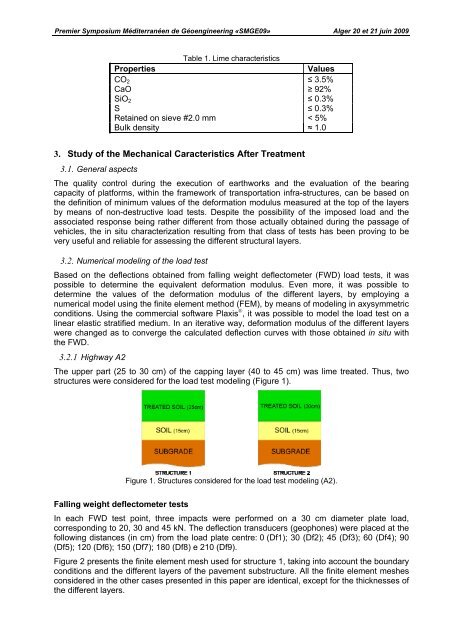Chef de projet : NOM Prnom - Repositório Aberto da Universidade ...
Chef de projet : NOM Prnom - Repositório Aberto da Universidade ...
Chef de projet : NOM Prnom - Repositório Aberto da Universidade ...
You also want an ePaper? Increase the reach of your titles
YUMPU automatically turns print PDFs into web optimized ePapers that Google loves.
Premier Symposium Méditerranéen <strong>de</strong> Géoengineering «SMGE09» Alger 20 et 21 juin 2009<br />
Table 1. Lime characteristics<br />
Properties<br />
Values<br />
CO 2 ≤ 3.5%<br />
CaO ≥ 92%<br />
SiO 2 ≤ 0.3%<br />
S ≤ 0.3%<br />
Retained on sieve #2.0 mm < 5%<br />
Bulk <strong>de</strong>nsity ≈ 1.0<br />
3. Study of the Mechanical Caracteristics After Treatment<br />
3.1. General aspects<br />
The quality control during the execution of earthworks and the evaluation of the bearing<br />
capacity of platforms, within the framework of transportation infra-structures, can be based on<br />
the <strong>de</strong>finition of minimum values of the <strong>de</strong>formation modulus measured at the top of the layers<br />
by means of non-<strong>de</strong>structive load tests. Despite the possibility of the imposed load and the<br />
associated response being rather different from those actually obtained during the passage of<br />
vehicles, the in situ characterization resulting from that class of tests has been proving to be<br />
very useful and reliable for assessing the different structural layers.<br />
3.2. Numerical mo<strong>de</strong>ling of the load test<br />
Based on the <strong>de</strong>flections obtained from falling weight <strong>de</strong>flectometer (FWD) load tests, it was<br />
possible to <strong>de</strong>termine the equivalent <strong>de</strong>formation modulus. Even more, it was possible to<br />
<strong>de</strong>termine the values of the <strong>de</strong>formation modulus of the different layers, by employing a<br />
numerical mo<strong>de</strong>l using the finite element method (FEM), by means of mo<strong>de</strong>ling in axysymmetric<br />
conditions. Using the commercial software Plaxis ® , it was possible to mo<strong>de</strong>l the load test on a<br />
linear elastic stratified medium. In an iterative way, <strong>de</strong>formation modulus of the different layers<br />
were changed as to converge the calculated <strong>de</strong>flection curves with those obtained in situ with<br />
the FWD.<br />
3.2.1 Highway A2<br />
The upper part (25 to 30 cm) of the capping layer (40 to 45 cm) was lime treated. Thus, two<br />
structures were consi<strong>de</strong>red for the load test mo<strong>de</strong>ling (Figure 1).<br />
Figure 1. Structures consi<strong>de</strong>red for the load test mo<strong>de</strong>ling (A2).<br />
Falling weight <strong>de</strong>flectometer tests<br />
In each FWD test point, three impacts were performed on a 30 cm diameter plate load,<br />
corresponding to 20, 30 and 45 kN. The <strong>de</strong>flection transducers (geophones) were placed at the<br />
following distances (in cm) from the load plate centre: 0 (Df1); 30 (Df2); 45 (Df3); 60 (Df4); 90<br />
(Df5); 120 (Df6); 150 (Df7); 180 (Df8) e 210 (Df9).<br />
Figure 2 presents the finite element mesh used for structure 1, taking into account the boun<strong>da</strong>ry<br />
conditions and the different layers of the pavement substructure. All the finite element meshes<br />
consi<strong>de</strong>red in the other cases presented in this paper are i<strong>de</strong>ntical, except for the thicknesses of<br />
the different layers.
















